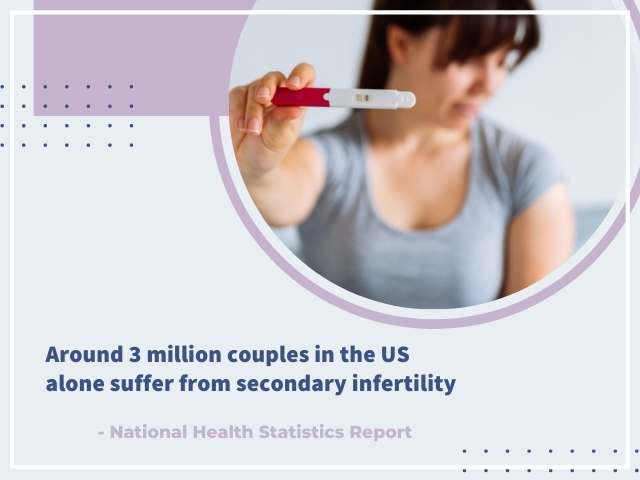If you have trouble conceiving after previous successful pregnancies, you may be suffering from secondary infertility. It affects around 11% of all couples in the US alone, according to the CDC (1), and if this includes you, there are ways to overcome secondary infertility.
The first step is always to determine the cause of the problem.

What are the main causes of secondary infertility?
The causes of secondary infertility are mostly the same as those for primary infertility. These include:
Female fertility problems
- Ovulation problems
- Endometriosis
- Certain medications, for example, chemotherapy drugs
- Autoimmune or thyroid disorders
- Hormonal imbalance
- Structural problems, such as fallopian tube blockage
- Age – fertility starts to decline around the age of 35
- Lifestyle factors – obesity, smoking, and excessive alcohol consumption.
Besides the above, there also may be a specific reason why you are struggling to conceive after a previous pregnancy, which could be:
- Advanced age – even a couple of years between pregnancies can greatly affect your fertility
- Previous Caesarean section(s) – as this can leave scarring or uterine adhesions which may create fertility problems
- Previously retained placenta – this can also leave scarring
- Declining health – worsening of previous reproductive disorder
Male factor infertility
- Decrease in sperm count, quality, or motility
- Testicular damage, may be due to infection, cancer or surgery
- Ejaculation problems
- Hormonal imbalances
- Certain medications
- Lifestyle factors – Excessive heat of testicles, drug or alcohol abuse, smoking, etc.
When should I see a doctor for secondary infertility?
If you have not had any success in trying to conceive for a year after your previous child, you should see a fertility expert.
If you had any complications during the previous child birth that could cause infertility, you should get medical help sooner.

What is the best treatment for secondary infertility?
The best treatment is always the one that gives you the desired result—in this case, a baby. As the first line of treatment for secondary infertility is usually lifestyle modifications, medications to induce ovulation or IUI.
Lifestyle modifications for secondary infertility
Certain lifestyle modifications may just help you to conceive and if not, they will certainly get you healthier, ready for your pregnancy.
Lifestyle improvements recommended to improve fertility include:
- Start moderate exercise for weight-loss
- Limit caffeine intake
- Cut down alcohol consumption and stop smoking
- Take prenatal vitamins and supplements to make up for any deficiencies
Medications
You may be offered medications, which are typically used to treat problems with ovulation. Commonly used fertility medications include:
- Clomifene (Clomid)
- Tamoxifen
- Metformin (typically used for women with PCOS)
Surgery
If you have been diagnosed with structural abnormalities, in the womb or fallopian tubes, you may be offered surgical treatments.
- Myomectomy – to remove fibroids or cysts. It is usually performed laparoscopically.
- Ovarian drilling – Helpful in bursting cyst membranes to trigger normal ovulation in women suffering from PCOS
- Fallopian tube surgery – to break up any scar tissue in your tubes
Assisted Conception
Usually this will be offered to you after other, less invasive measures have been ruled out. Treatment options include:
- Intrauterine insemination (IUI)
- In vitro fertilisation
- Donor egg IVF
- Donor sperm IVF
What tests will be performed?
Your doctor will initially perform a series of tests to investigate what is happening.
The following tests are usually recommended:
- Physical examination – to check the pelvis for signs of infection, lumps or problems such as endometriosis
- Weight check – to ensure that your BMI isn’t too high
- Blood test – to determine hormone levels and check to see if you are ovulating
- A hysterosalpingogram (HSG) – this is a dye contrast X-Ray test which can determine whether your fallopian tubes are blocked
- An ultrasound scan – to check for any structural problems with the womb, ovaries and fallopian tubes
- Laparoscopy – this is keyhole surgery, where a camera is inserted to look more clearly at your womb, ovaries and fallopian tubes. This is usually only advised if other scans suggest there is a blockage or structural problem present.
- Hormone analysis – any imbalance in fertility hormones such as FSH, Prolactin, LH, AMH, and testosterone may indicate a problem.
For the male partner:
- Semen analysis – to check the sperm count, quality, and motility
How successful is IVF for secondary infertility?
After studying hundreds of couples with secondary infertility, researchers found that their infertility was most commonly cause by ovulation disorders and they also were the fastest to get pregnant after medical intervention. (2)
Already having a child increases your odds of having a second baby. Cumulative pregnancy rates after 3 years were found to be 56% in couples with secondary fertility and 44% in people with primary infertility.
To consult with an experienced doctor and plan your IVF for secondary infertility, get in touch using the red button below. Prices for IVF start at $4,700 all inclusive.
References
- Katib, A. A., Al-Hawsawi, K., Motair, W., & Bawa, A. M. (2014). Secondary infertility and the aging male, overview. Central European journal of urology, 67(2), 184–188. https://doi.org/10.5173/ceju.2014.02.art13
- Collins, J. A., Rand, C. A., Wilson, E. H., Wrixon, W., & Casper, R. F. (1986). The better prognosis in secondary infertility is associated with a higher proportion of ovulation disorders. Fertility and sterility, 45(5), 611–616. https://doi.org/10.1016/s0015-0282(16)49330-1
Reviewd by: Dr. Meenakshi, PhD